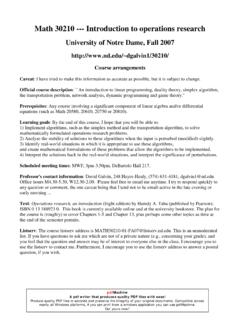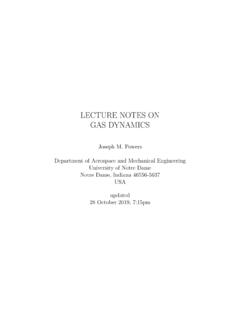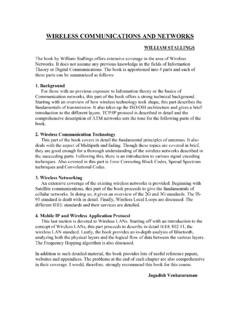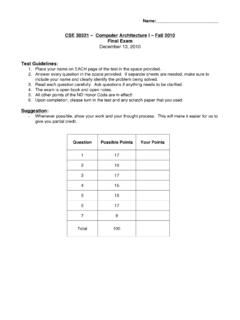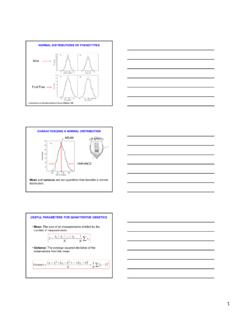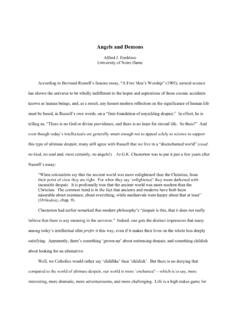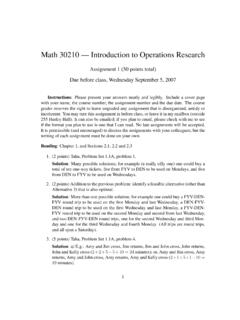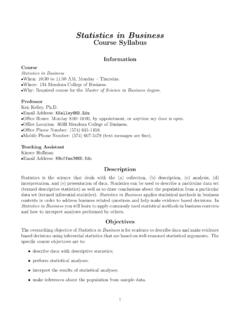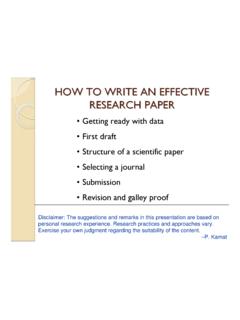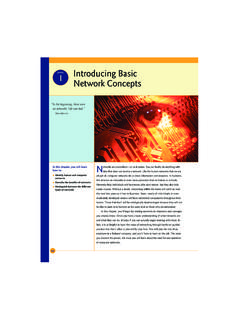Transcription of Advanced Physics Laboratory Manual Department of …
1 Advanced Physics Laboratory Manual Department of Physics university of Notre Dame 2008. Edited by Hammer Contents I. GENERAL INFORMATION 3. Introduction .. 16. II . A. GENERAL EXPERIMENTS 17. 1 Statistics .. 17. 2 Speed of Light Experiment using positron annihilation and ultrafast timing techniques .. 25. II . B. ATOMIC Physics EXPERIMENTS 35. 3 Optical Diffraction and Interference using Single Photon Counting .. 35. 4 Saturation Spectroscopy .. 41. 5 X-Ray-Spectroscopy and Moseley's Law .. 49. II . C. NUCLEAR Physics EXPERIMENTS 65. 6 Alpha Spectroscopy .. 65. 7 Beta Spectroscopy .. 74. 8 Gamma Spectroscopy .. 85. 9 Compton Effect .. 104. 10 Rutherford Scattering .. 117. 11 Lifetime of Excited Nuclear States .. 127. 2 CONTENTS. 12 Gamma Gamma Angular Correlation .. 134. 13 Multidimensional Coincidences Determination of a Nuclear Level Scheme .. 144. 14 Neutron Spectroscopy.
2 151. II . D. ELEMENTARY PARTICLES EXPERIMENTS 159. 15 Cosmic Ray Experiment .. 159. 16 Muon Lifetime Experiment Determination of the Fundamental Weak Cou- pling Constant .. 169. II . E. CONDENSED MATTER EXPERIMENTS 177. 17 X-Ray Diffraction and Crystal Structure (XRD) .. 177. 18 Material Analysis using X-ray Fluorescence (XRFA) .. 188. 19 Electron Spin Resonance (ESR) .. 202. 20 Nuclear Magnetic Resonance (NMR) .. 206. 21 M bauer Effect .. 212. 22 Angular Correlation of Annihilation Radiation (ACAR) .. 219. 23 Positron Annihilation Lifetime Spectroscopy (PALS) .. 226. 24 Perturbed Angular Correlation (PAC) .. 231. III. APPENDIX 239. 25 Tables of Important Constants, Units and Conversion Factors .. 239. 26 Units, Abbreviations, and Conversion Formulas .. 244. I. GENERAL INFORMATION. A. Introduction This Lab Manual will provide the necessary information to perform the experiments in a reason- able time.
3 It cannot substitute reading of relevant literature nor will it work as a "cookbook" . experimental expertise has to be aquired through your own exercise and careful thoughts about the experiments. However, if well prepared and applying very careful experimental skills the student can expect results which can compare with the best in literature. B. General Remarks . The aim of a lab course in the Advanced Physics Teaching Lab is: Learn Physics by proper preparation for the experiments and by doing. Learn experimental techniques. All theories have to be proven by experiments and new discoveries mostly come from very Advanced measurements. Working in experimental research requires techniques at the technical limits and the knowledge can be acquired by training. The fight for better experimental results can only be won in the field . The subsequent treatment of data on a computer cannot serve as a substitute for good experimental pro- cedures but it should complement them.
4 Training with established classical experiments should give the students confidence that Physics works and enables them later to explore new fields. Training of experimental techniques promotes interest and ones own creativity. Learn how to review the results critically and to get a realistic estimate of uncertainties 4 GENERAL INFORMATION. Learn some practical experiences in applied fields: electronics and signals, data process- ing with computers, experience with large data banks over the internet, vacuum technique, safe handling of radioactive material and measurement of radiation, appropriate presen- tation of results, just to mention a few. C. Homework Time is required for appropriate preparation of the lab (homework). Use the precious lab time for measurement and learning. The final evaluation of the measurements and the writing of the reports is mainly home- work !
5 But some diagrams and preliminary results should be obtained in the lab immedi- ately after the measurement, to get an idea whether the measurement was right. Of course questions about the evaluation and the writing of the reports should be dis- cussed with the teaching personnel/staff. All measures are taken in international standards, the SI-system (95% of the world's population and all scientists are using it). D. Organisational Remarks The experiments are performed by the students in groups of two. Schedule the experiments (new or extension) one week in advance with the TA's. Each group has to come prepared about the theory of the experiment before the lab starts. The students should understand the experiment before they start with setup and measur- ing. There may be questioning by the TA's before starting the experiment. Each group writes down all important information in a bound logbook, which is a docu- ment and a lab diary.
6 All information which can be plotted should be shown graphically already during the lab. Finishing of an experiment needs to be approved either by the prof or the TA's. After the lab an experimental report has to be written and handed in within 14 days after completion of the experimentm as a first draft. This draft will be corrected by the teaching staff and returned promptly for a second draft which should be final. The final report version needs to be approved. 5. All set-ups using electronic equipment should be performed by using an oscilloscope and by watching and understanding the signals. No trials without understanding ! Do ask the TA's and the professor ! For most of the experiments an appropriate selection of electronic units has been made which warrants a successful measurement and good results. If you want to try out some- thing different, discuss it first with the teaching personnel.
7 Follow the safety rules given below and those taught in the risk management course. In case you are not sure, ask first ! Never play with or abuse radioactive sources. Do not change the computer-settings, don't install or download your own software; re- pairs of damaged computer software are a waste of time and we need our time for you. E. Grading for the course is based on a selection of the following (will be announced) : 1. Preparation for the scheduled experiment 2. Efforts during the Laboratory session and volume of the work done; merely presence is not sufficient. 3. Quality of the reports 4. Midterm and final examination 5. Special tasks can be defined by the professor as for example a presentation at the white- board (or ppt) or the preparation of a poster (format DIN A0) with high quality. 6. A special task can also be a very accurate and exceptionally well-prepared and detailed lab report on an experiment or a new variant of it.
8 6 GENERAL INFORMATION. F. Experiments in the Advanced Physics Lab A. General Experiments 14. a) Neutron Spectroscopy b) Neutron Diffusion 1. Statistics 2. Speed of Light D. Elementary Particles 15. Cosmic Ray Experiment B. Atomic Physics 16. Muon Lifetime Experiment 3. Optical Diffraction and Interference 4. Saturation Spectroscopy E. Condensed Matter Experiments 5. Moseley's Law and X-Ray Spectros- 17. X-Ray Diffraction and Crystal Struc- copy ture 18. Material Analysis (XRFA). C. Nuclear Physics 19. Electron Spin Resonance (ESR). 6. Alpha-Spectroscopy 20. Nuclear Magnetic Resonance (NMR). 7. Beta-Spectroscopy 21. M bauer Spectroscopy 8. Gamma-Spectroscopy 22. ACAR. 9. Compton-Scattering 23. Positron Lifetime 10. Rutherford-Scattering 24. Perturbed Angular Correlation 11. Lifetime of Excited Nuclear (PAC). States 12. - -Angular Correlation 13. Multiple Coincidences 7.
9 G. General Literature and Textbooks Adrian C. Melissinos, Jim Napolitano, Experiments in Modern Physics , Academic Press, (Elsevier) Amsterdam .. Tokyo (2003). Philip R. Bevington, D. Keith Robinson, Data Reduction and Error Analysis, Mc Graw Hill, Boston .. Toronto (2003 third ed.). Les Kirkup, Data Analysis with Excel, Cambridge university Press, Cambridge, NY, Port Melbourne, Cape Town (2003 reprint). Paul A. Tipler, Gene Mosca, Physics for Scientists and Engineers, W. H. Freeman (2007). Hugh D. Young, Roger A. Freedman, Lewis Ford, university Physics with Modern Physics , Addison Wesley (2007). More General Literature and Textbooks: Glenn F. Knoll, Radiation Detection and Measurement, Wiley (2000). G nter Schatz, Alois Weidinger, Nuclear Condensed Matter Physics : Nuclear Methods and Applications, Wiley (1996). Christian Iliadis, Nuclear Physics of Stars, Wiley (2007).
10 Kenneth S. Krane, Introductory Nuclear Physics , John Wiley and Sons (2006). Gordon L. Kane, Modern Elementary Particle Physics , Westview Press (1993). Charles Kittel, Introduction to Solid State Physics , Wiley (2004). Peter Y. Yu, Manuel Cardona, Fundamentals of Semiconductors: Physics and Materials Properties, Springer (2005). Francis A Jenkins, Harvey E White, Fundamentals of Optics, McGraw-Hill (2001). Max Born, Atomic Physics , Dover Publications (1989). Dmitry Budker, Derek F. Kimball, David P. DeMille, Atomic Physics : An Exploration through Problems and Solutions, 8 GENERAL INFORMATION. Oxford university Press (2004). H. Safety in the Experimental Course. The students need to learn how to safely handle risks in a lab environment: Potential Mechanical, Thermal and Chemical Dangers: Falling objects, negative pressure, positive pressure, refrigerants (liquid nitrogen), chemicals.
